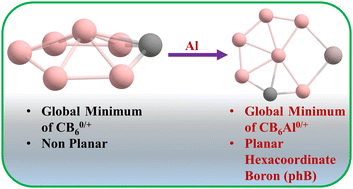CB6Al0/+: Planar hexacoordinate boron (phB) in the global minimum structure†
Abstract
Herein, we report for the first time the presence of a planar hexacoordinate boron (phB) atom in the global minimum energy structure of a neutral cluster system. The potential energy surface (PES) has been explored for CB6Al0/+/− systems using density functional theory (DFT). The global minima of CB6Al (1a) and CB6Al+ (1b) contain a phB center. However, the global minimum of CB6Al− (1c) does not have a phB atom. The CCSD(T)/aug-cc-pVTZ level of theory has been applied to compute the relative energies of the low-lying isomers with respect to the 1a and 1b structures of CB6Al and CB6Al+ systems, respectively. The exploration of the PES of CB60/+/− systems indicates that the global minima do not contain a phB atom. However, the incorporation of an aluminium (Al) atom into the CB6 moiety produces structures containing a phB center in the CB6Al0/+ systems. Hence, the Al metal has an important role in attaining a planar geometry having a hexacoordinate boron center. The dynamical stability of CB6Al (1a) and CB6Al+ (1b) was confirmed from the atom-centered density matrix propagation (ADMP) simulation over 20 ps of time at temperatures of 300 K and 400 K. The natural charge computations showed that the charges on the phB are almost zero in both systems. The 1a structure has σ/π-dual aromaticity as predicted from the nucleus independent chemical shift (NICS) values and the gauge-including magnetically induced ring current (GIMIC).



 Please wait while we load your content...
Please wait while we load your content...